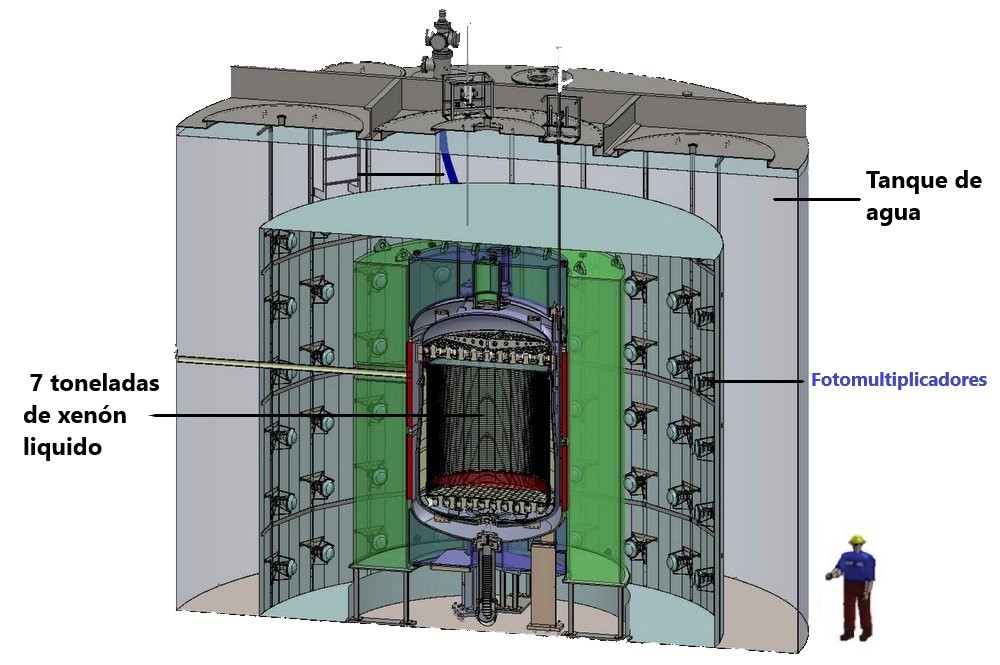Astronomy The history of the moons Dione and Tethys is written in their craters
The astronomer Rafael Bachiller reveals to us in this series the most spectacular phenomena of the Cosmos.
Topics of exciting research, astronomical adventures and scientific news about the Universe analyzed in depth.
The first results of the
LUX-ZEPLIN
experiment , the most sensitive of its kind in the world, do not provide any detection of
dark matter
, but the prospects are encouraging.
Very abundant but dark
One of the most burning problems in physics today is the detection of dark matter.
We know that it is there and that it is about 5 times more abundant than
ordinary matter
.
Its existence has been known for ninety years, it is unambiguously deduced from the movement of
stars and galaxies
.
During the last decades, great efforts have been invested for its direct detection, but none has yielded positive results until now.
And not only has it not been detected directly, but we still do not have a clear idea of what its composition may be.
The most promising candidates for dark matter are elementary particles known as
WIMPS
, which stands for "weakly interacting particles with mass."
But this is not the only option, other particles such as some kind of neutrino with mass or axions are also on the list of candidates.
It has even come to be thought of
astronomical bodies
that could go unnoticed, such as small dark stars or clouds of non-luminous gas.
However, the most favored hypothesis in current physics is that the primary component of dark matter must be some kind of elementary particles, quite possibly the aforementioned WIMPS.
7 tons of xenon
As their name suggests, the hypothetical WIMPS barely interact with ordinary matter.
A WIMP could
traverse a region of millions of light years filled with solid lead
before colliding with the nucleus of one of its atoms.
Because of this, WIMPS are extremely difficult to catch.
However, to account for all the dark matter that must exist in the universe, billions of WIMPS would have to be passing through our planet, including our bodies, every second, so an extremely sensitive detector that had been running for long times, it could register an event from time to time.
This is the principle behind the
LUX-ZEPLIN
experiment using a large 7-ton tank of
liquid xenon
buried under a mountain at the
Sanford Underground Research Facility
(SURF) in South Dakota.
Xenon, with a very high degree of purity, is very carefully protected from all possible sources of particles that could create background noise and mask the arrival of dark matter.
To do this, the xenon tank is contained in a larger tank filled with 238 tons of ultrapure water.
Radioactive emission from materials in the environment and cosmic rays are the main causes of background noise.
LUX-ZEPLIN.SURF/RB detector section
When a particle of dark matter collides with a xenon nucleus, primary photons and electrons will be produced, which, in turn, will ionize some xenon atoms, generating secondary photons.
About 500 photomultiplier tubes, surrounding the xenon deposit, are in charge of detecting these weak light signals.
The time difference in the production of the primary and secondary signal, and their energies, allow us to unequivocally identify the arrival of a dark matter particle, discriminating against background noise.
Not a WIMP in sight
The
collaboration
of some 250 researchers from 35 institutes spread over four countries (USA, UK, Portugal and South Korea) has just published the analysis of the data obtained by LUX-ZEPLIN during the 60-day campaign that began at the end of last year.
The result in a nutshell:
no WIMP detected
, but the whole system works fine, even a little better than projected.
WIMPS are so elusive that this initial result
hasn't surprised anyone.
But the limits obtained give some clues as to where the search should continue and in the experiment
LUX-ZEPLIN hope to compile at least 20 times more data, greatly increasing the chances of detection.
Although it is the most sensitive, this is not the only experiment designed to detect dark matter, the Italian XENOXnT has completed a 100-day data collection campaign and its researchers are now immersed in the analysis.
The DARWIN experiment is expected to be completed by 2026 in a location yet to be determined (perhaps also in Italy).
Looking at the future
And the three international collaborations,
LUX-ZEPLIN, XENONnT and DARWIN
have started talks to join forces and design an experiment that could be much more ambitious than any of these three.
As we can see, despite the lack of positive results, the hunt for dark matter does not stop.
To these experiments based on liquid xenon we must add the searches carried out at
CERN
through particle collisions.
With the start of a new collision campaign (called Run 3) that is breaking a world record for energy at 13.6 billion electron volts (13.6 TeV), CERN will bring us many joys;
hopefully, among them, is the detection of dark matter.
The article with the initial results of the LUX-ZEPLIN experiment, entitled "First Dark Matter Search Results from the LUX-ZEPLIN (LZ) Experiment", can be found at this link.
Rafael Bachiller is the director of
the National Astronomical Observatory
(National Geographic Institute) and an academic of the
Royal Academy of Doctors of Spain
.
Conforms to The Trust Project criteria
Know more
Astronomy

